Molecular mechanisms: New pathway for fragile X treatment
Inhibiting the ERK1/2 pathway — which regulates the synthesis of other proteins — can rescue some of the effects of fragile X syndrome, according to a study published 17 November in the Journal of Neuroscience. The ERK pathway could provide a novel target for fragile X therapies.
Inhibiting the ERK1/2 pathway — which regulates the synthesis of other proteins — can rescue some of the effects of fragile X syndrome, according to a study published 17 November in the Journal of Neuroscience. The ERK pathway could provide a novel target for fragile X therapies.
Fragile X syndrome is caused by lack of the fragile X mental retardation protein, or FMRP, which controls the production of several proteins important at the synapse, the junction between neurons. Some therapies for fragile X syndrome target the mGluR receptor, which also regulates protein synthesis.
In the new study, researchers show that protein synthesis overall is higher in a slice of the hippocampus removed from the brains of fragile X mice. Inhibiting both the mGluR receptor and ERK1/2 — a pathway that mGluR activates — restores protein synthesis to normal levels, the researchers show. By contrast, inhibiting mTOR1 — another pathway also thought to be involved in fragile X syndrome — does not restore protein synthesis.
Injecting an inhibitor of the ERK pathway into the brains of fragile X mice also prevents seizures triggered by loud noise — a known characteristic of this mouse model.
The researchers show that the loss of FMRP does not increase mGluR and ERK1/2 signaling overall. Rather, it may make the cells more sensitive to proteins regulated by these pathways.
Recommended reading

Ramping up cortical activity in early life sparks autism-like behaviors in mice

New method identifies two-hit genetic variation in autism; and more

Protein tug-of-war controls pace of synaptic development, sets human brains apart
Explore more from The Transmitter

Psychedelics muddy fMRI results: Q&A with Adam Bauer and Jonah Padawer-Curry

First Pan-African neuroscience journal gets ready to launch
